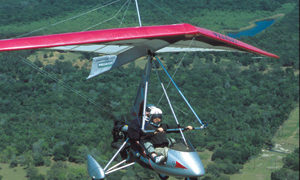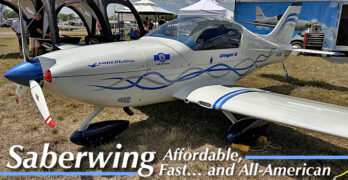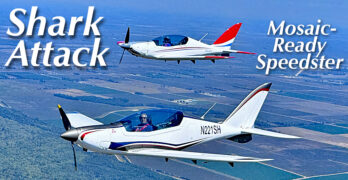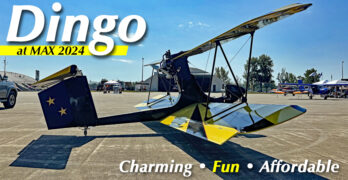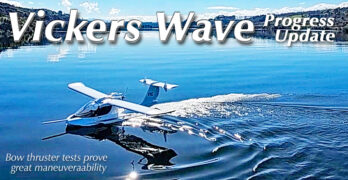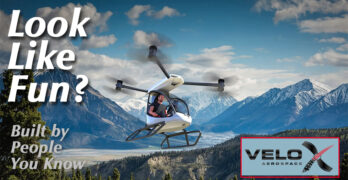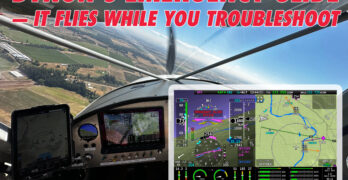This month I wrote a pilot’s report about two widely different aircraft, both of which are imported by Rollison Airplane Company. Here’s how I handled it.
Every “Ultralight Flying! Pilot’s Report” has common elements: a main article, photos and photo legends, specifications, and our exclusive “Report Card.” Because the two subject flying machines are so different this month, I’ve prepared a “Report Card” for each aircraft. I did the same for specifications as the standard and optional features obviously differ too much for grouping.
In the main article, I take alternate looks at the two flying machines as a way to observe their differences, but further how they each have their benefits.
I also selected more photos – even though Ultralight Flying! reports regularly present many photos of ultralights being reviewed as readers often say that photos are a key informative element.
Because reviewing two different craft makes for a longer pilot report, I’ve somewhat abbreviated both the main article and the twin “Report Cards.”
Quite a few general aviation pilots recognize that ultralights offer a different way to fly| and that’s precisely what they like about them.
Search Results for : flight design ct
Not finding exactly what you expected? Try our advanced search option.
Select a manufacturer to go straight to all our content about that manufacturer.
Select an aircraft model to go straight to all our content about that model.
Flex-Wing or Fixed Wing
This month I wrote a pilot’s report about two widely different aircraft, both of which are imported by Rollison Airplane Company. Here’s how I handled it.
Every “Ultralight Flying! Pilot’s Report” has common elements: a main article, photos and photo legends, specifications, and our exclusive “Report Card.” Because the two subject flying machines are so different this month, I’ve prepared a “Report Card” for each aircraft. I did the same for specifications as the standard and optional features obviously differ too much for grouping.
In the main article, I take alternate looks at the two flying machines as a way to observe their differences, but further how they each have their benefits.
I also selected more photos – even though Ultralight Flying! reports regularly present many photos of ultralights being reviewed as readers often say that photos are a key informative element.
Because reviewing two different craft makes for a longer pilot report, I’ve somewhat abbreviated both the main article and the twin “Report Cards.”
Quite a few general aviation pilots recognize that ultralights offer a different way to fly| and that’s precisely what they like about them.
Affordable and Speedy — Saberwing from Azalea plus Spyder Engine
After taking an airshow sabbatical during all of 2024, I was pleased to discover an aircraft at Sun ‘n Fun 2025 that I had never reviewed.
Welcome to Saberwing, an affordable composite kit from Azalea Aviation, which distinguishes itself by also providing an engine to fit the aircraft. Oh, and it’s affordable!
Let’s discover more.
Saberwing and Spyder
Based in Quitman, Georgia, Azalea’s Saberwing was designed for amateur builders seeking a speedy two seater in the LSA description. It has not qualified as a Special LSA but designer and company CEO Bill Clapp said he will consider meeting Mosaic LSA standards when released later this year.
Introduced ten years ago at Sun ’n Fun 2015, this low-wing EAB is “designed to address challenges in the kit aircraft market, emphasizing a simplicity to the kit’s components with fast assembly (500-1,000 hours).” For comparison, RVs often take more than 3,000 hours.
Mosaic! …Or No Mosaic (Yet)? — That Is the Question
OK, so we have a new U.S. President and Trump often promised to “Eliminate 10 new rules for every new one proposed.”
On the campaign trail, this was only promises, such as every politician makes. Now comes reality. Will our new president do what he said?
Regular readers will recognize Roy Beisswenger. Roy and I made several trips to Washington, DC in an attempt by LAMA, the Light Aircraft Manufacturers Association, to encourage FAA to make changes to the then-10-year-old Sport Pilot / Light-Sport Aircraft regulation. Our work, starting in 2014, began a few years before anyone knew anything about Mosaic. Being involved for ten years provided lots of knowledge about FAA rule making, leading to actions later known as Mosaic.
In his day job, Roy is the proprietor of Easy Flight, the nation’s premiere powered parachute educator and flight trainer. Follow the link to learn more.
Shark Attack — Review and Video of a Striking Mosaic-Ready Aircraft
Readers who scour the Internet looking for fascinating Light-Sport Aircraft may already know Shark. Conceived by Jaro Dostal in the Czech Republic, this design is the latest from a man who has a long, storied history of aircraft for the light aviation set.
Jaro’s work included the Skyboy from the early days of LSA and later the MD-3 SportRider. Both won approval from many pilots.
All Jaro’s designs have one common easily-seen design characteristic: his shark fin vertical tail. Of course, this one is no different in that respect but it is the first to openly embrace the name. With this speedy aircraft already flying in North America and with more on the way, I couldn’t resist the compelling “Shark Attack” title. Let’s check it out.
Shark.Aero
Shark is built at a factory in the country of Slovakia in a region said to be well known for producing innovative designs.
Bingo! It’s Dingo… A Charming, Fun, Affordable Part 103 Ultralight Biplane
If you look at Dingo and smile, you may be an ultralighter. Appearance and qualities about Future Vehicles‘ single seat bi-wing flying machine attract certain pilots like bees to a bright flower.
If you must have two seats, large flat screen displays, an autopilot, and luxurious appointments, you probably are not attracted to Dingo. Fine. The good news is that you’ll have plenty of choices among Mosaic LSA.
Those of us still smiling at the nearby images might already be captivated. If you are caught by Dingo’s interesting specs and its affordability, you might want to learn more. So, here’s more…
Dingo Is for Fun
Shown to Americans for the first time at MAX 2024 (Midwest Aviation Expo) by Bluff City Aircraft, Dingo drew steady interest from the fun flying crowd. For a grin-producing flight at the end of your workday, Dingo might be just about perfect.
Changing LSA Seaplane Market — Vickers Wave Progress Update — Others, Hmmm…?
Winter is coming, so naturally, it’s time to start thinking about seaplanes… right? It always seems weird to write about water-based activities as frost begins to envelop the northern two-thirds of the country. Yet winter is when all the big boat shows happen because buying new vessels requires advance planning. It’s also pleasant to think about spring and summer while snow flurries fly.
For many years I’ve written about this sector and names like Searey, Seamax, and Aventura (all in nearby image) have long been the leading brands. Now the first two are in financial trouble and the last has decamped to Brazil from Florida. Whatever is going on, Vickers Wave may represent a breath of fresh air.
In articles last fall and this spring, I gave overviews of the entire LSA seaplane market (read here or here).
Vickers Wave Update
Vickers previously noted, “Wave has finished its flight testing, resulting in a 120-knot cruise and useful load of 750 pounds powered by a Rotax 916iS (reviewed here).”
“A frequently asked question I receive is, ‘What is taking so long?’,” begins Paul Vickers.
Higher Flyer: The WT9 Dynamic Turbo
Lined up on the runway, I open the throttle to the stop. The Dynamic surges forward, my right thumb presses a small button at the base of the throttle quadrant and I push the lever further forward. In an instant there’s 15% more thrust and the speed tape really starts to roll. Ease back on the stick and we’re airborne after a very short ground roll and climbing away at well over 1200 fpm.
Flaps up, and 20 seconds later we’re passing through 400 feet, I pull the power back past the detent and the turbocharger control unit (TCU) reduces boost to 35 inches of manifold pressure. I then lower the nose, dial the prop rpm down to 5500 engine rpm and note the VSI is still showing around 1000 fpm before swinging the shapely spinner onto a south-easterly heading. Already I can see that the field of view is phenomenal and feel that the handling is crisp and taut.
A Multicopter Current Pilots Might Enjoy? …Developed Within Our LSA Industry
Here’s a helicopter-like aircraft you might actually consider. I have often reviewed what I call multicopters (several articles). I searched for aircraft you might fly for fun; several of them can enjoy the freedom and special benefits of Part 103. I’ve stayed away from commercial “air taxi” projects.
But what if a longtime producer of Light-Sport Aircraft entered the space? What if the aircraft looked like a helicopter but one you could fly without the steep learning curve? What if it offered 45 minutes of flight with a 15-minute reserve?
The earliest entries had short flight times, 15-20 minutes. Most of them cost too much. For example, Opener’s Blackfly (now called Helix) was first promoted at the cost of a “luxury SUV,” perhaps meaning $80,000 at the time. It has since more than doubled in price.
You may doubt or dislike these flying machines, especially when you don’t know the people behind the projects.
Flying Dynon’s Emergency Glide Feature — Go Down Easy (UPDATED)
I probably shouldn’t admit this, but some features that come with the latest electronic flight instruments have left me a little, um, disinterested. Until I try them, that is. A good example is the concept of “safe glide” or even autoland. Garmin introduced both concepts a few years ago, though the full-autoland idea is more recent and limited to high-end aircraft where the system can control the engine directly. That’s not at my pay grade.
The more common version is what Garmin calls Smart Glide and, more recently, Dynon rolled out what it calls Emergency Glide. They work similarly: When commanded, they set up a controlled descent to the nearest viable airport and let the pilot concentrate on other things. To be honest, I was a bit meh about them as safety features. After all, you’re trained to set the airplane up for best-glide speed as soon as you recognize a power failure and all good pilots fly along considering which airports beneath them are reachable.
- « Previous Page
- 1
- …
- 38
- 39
- 40
- 41
- 42
- …
- 145
- Next Page »



